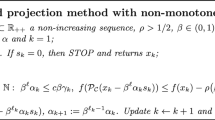Abstract
The “relaxation” procedure introduced by Held and Karp for approximately solving a large linear programming problem related to the traveling-salesman problem is refined and studied experimentally on several classes of specially structured large-scale linear programming problems, and results on the use of the procedure for obtaining exact solutions are given. It is concluded that the method shows promise for large-scale linear programming
Similar content being viewed by others
References
J. Abadie and M. Sakarovitch, “Two methods of decomposition for linear programming”, in:Proceedings of the Princeton symposium on mathematical programming Ed. H.W. Kuhn (Princeton University Press, Princeton, N.J., 1970) pp 1–23.
S. Agmon, “The relaxation method for linear inequalities”,Canadian Journal of Mathematics 6 (1954) 382–392.
D.P. Bertsekas and S.K. Mitter, “Steepest descent for optimization problems with nondifferentiable cost functionals”, in:Proceedings of the 5 th annual Princeton conference on information sciences and systems, 1971.
G.B. Dantzig, D.R. Fulkerson and S.M. Johnson, “Solution of a large-scale traveling-salesman problem”,Operations Research 2 (1954) 393–410.
V.F. Dem'janov, “Seeking a minimax on a bounded set”,Soviet Mathematics Doklady 11 (1970) 517–521. [Translation of:Doklady Akademii Nauk SSSR 191 (1970).]
M.L. Fisher and J.F. Shapiro, “Constructive duality in integer programming”, Working Paper OR 008-72, Operations Research Center, Massachusetts Institute of Technology, Cambridge, Mass. (April, 1972).
L.R. Ford, Jr. and D.R. Fulkerson,Flows in networks (Princeton University Press, Princeton, N.J., 1962).
A.M. Geoffrion, “Elements of large-scale mathematical programming”,Management Science 16 (1970) 652–691.
R.C. Grinold, “Steepest ascent for large-scale linear programs”,SIAM Review 14 (1972) 447–464.
M. Held and R.M. Karp, “The traveling-salesman problem and minimum spanning trees”,Operations Research 18 (1970) 1138–1162.
M. Held and R.M. Karp, “The traveling-salesman problem and minimum spanning trees: part II”,Mathematical Programming 1 (1971) 6–25.
M. Held and R.M. Karp, “A dynamic programming approach to sequencing problems”,Journal of the Society for Industrial and Applied Mathematics 10 (1962) 196–210.
L.L. Karg and G.L. Thompson, “A heuristic approach to solving traveling-salesman problems”,Management Science 10 (1964) 225–248.
H.W. Kuhn and A.W. Tucker, “Nonlinear programming”, in:Proceedings of the second Berkeley symposium on mathematical statistics and probability Ed. J. Neyman (University of California Press, Berkeley, Calif., 1951) pp. 481–492.
L.S. Lasdon,Optimization theory for large systems (Macmillan, London, 1970).
R.E. Marsten and J.W. Blankenship, “Boxstep: a new strategy for Lagrangian decomposition”, Department of Industrial Engineering and Management Sciences, Northwestern University, Evanston, Ill. (March, 1973).
T. Motzkin and I.J. Schoenberg, “The relaxation method for linear inequalities”,Canadian Journal of Mathematics 6 (1954) 393–404.
J. von Neumann, “A certain zero-sum two-person game equivalent to the optimal assignment problem”, in:Contributions to the theory of games, Vol. II, Eds. H.W. Kuhn and A.W. Tucker, Annals of Mathematics Study No. 28 (Princeton University Press, Princeton, N.J., 1953).
W. Oettli, “An iterative method, having linear rate of convergence, for solving a pair of dual linear programs”,Mathematical Programming 3 (1972) 302–311.
B.T. Poljak, “A general method of solving extremum problems”, Soviet Mathematics Doklady 8 (1967) 593–597. [Translation ofDoklady Akademii Nauk SSSR 174 (1967).]
B.T. Poljak, “Minimization of unsmooth functionals”,U.S.S.R. Computational Mathematics and Mathematical Physics 14–29. [Translation of: Žurnal Vyčislitel'no\(\mathop i\limits^ \vee \) Matematiki i Matematičesko\(\mathop i\limits^ \vee \) Fiziki 9 (1969) 509–521.]
R.T. Rockafellar,Convex analysis (Princeton University Press, Princeton, N.J., 1970).
N.Z. Shor, “On the structure of algorithms for the numerical solution of optimal planning and design problems”, Dissertation, Cybernetics Institute, Academy of Sciences U.S.S.R. (1964).
P. Wolfe, M. Held and R.M. Karp, “Large-scale optimization and the relaxation method”, in:Proceedings of the 25 th national ACM meeting, Boston, Mass. (August 1972).
Author information
Authors and Affiliations
Rights and permissions
About this article
Cite this article
Held, M., Wolfe, P. & Crowder, H.P. Validation of subgradient optimization. Mathematical Programming 6, 62–88 (1974). https://doi.org/10.1007/BF01580223
Received:
Revised:
Issue Date:
DOI: https://doi.org/10.1007/BF01580223




